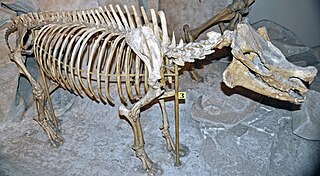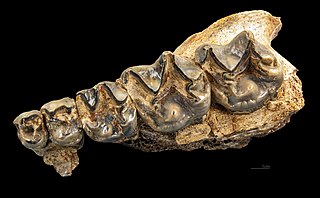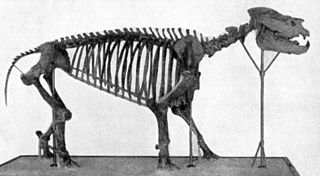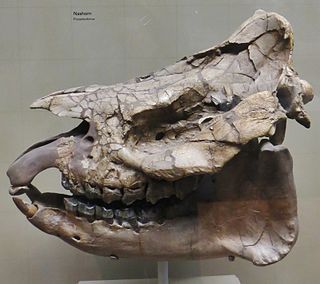
The Oligocene is a geologic epoch of the Paleogene Period that extends from about 33.9 million to 23 million years before the present. As with other older geologic periods, the rock beds that define the epoch are well identified but the exact dates of the start and end of the epoch are slightly uncertain. The name Oligocene was coined in 1854 by the German paleontologist Heinrich Ernst Beyrich from his studies of marine beds in Belgium and Germany. The name comes from Ancient Greek ὀλίγος (olígos) 'few' and καινός (kainós) 'new', and refers to the sparsity of extant forms of molluscs. The Oligocene is preceded by the Eocene Epoch and is followed by the Miocene Epoch. The Oligocene is the third and final epoch of the Paleogene Period.

Teleoceras is an extinct genus of rhinocerotid. It lived in North America during the Miocene and Pliocene epochs during the Hemingfordian to the end of Hemphillian from around 17.5 to 4.9 million years ago. It grew up to lengths of 13 feet long.

Dicerorhinus is a genus of the family Rhinocerotidae, consisting of a single extant species, the two-horned Sumatran rhinoceros, and several extinct species. The genus likely originated from the Late Miocene of central Myanmar. Many species previously placed in this genus probably belong elsewhere.

Menoceras is a genus of extinct, small rhinocerotids endemic to most of southern North America and ranged as far south as Panama during the early Miocene epoch. It lived from around 30.7—19.7 Ma, existing for approximately 11 million years.

Paraceratherium is an extinct genus of hornless rhinocerotoids belonging to the family Paraceratheriidae. It is one of the largest terrestrial mammals that has ever existed and lived from the early to late Oligocene epoch. The first fossils were discovered in what is now Pakistan, and remains have been found across Eurasia between China and the Balkans. Paraceratherium means "near the hornless beast", in reference to Aceratherium, the genus in which the type species P. bugtiense was originally placed.

Chalicotherium is a genus of extinct odd-toed ungulates of the order Perissodactyla and family Chalicotheriidae. The genus is known from Europe and Asia, from the Middle Miocene to Late Miocene.

Metamynodon is an extinct genus of amynodont that lived in North America and Asia from the late Eocene until early Oligocene, although the questionable inclusion of M. mckinneyi could extend their range to the Middle Eocene. The various species were large, displaying a suit of semiaquatic adaptations more similar to those of the modern hippopotamus, despite their closer affinities with rhinoceroses.

The John Day Formation is a series of rock strata exposed in the Picture Gorge district of the John Day River basin and elsewhere in north-central Oregon in the United States. The Picture Gorge exposure lies east of the Blue Mountain uplift, which cuts southwest–northeast through the Horse Heaven mining district northeast of Madras. Aside from the Picture Gorge district, which defines the type, the formation is visible on the surface in two other areas: another exposure is in the Warm Springs district west of the uplift, between it and the Cascade Range, and the third is along the south side of the Ochoco Mountains. All three exposures, consisting mainly of tuffaceous sediments and pyroclastic rock rich in silica, lie unconformably between the older rocks of the Clarno Formation below and Columbia River basalts above.

Prosantorhinus is an extinct genus of rhinocerotid that lived during the Early and Middle Miocene subepochs. The small teleoceratine rhinocerotid was found in Western Europe and Asia.

Vulpavus is an extinct paraphyletic genus of placental mammals from clade Carnivoraformes, that lived in North America from the early to middle Eocene.

Palaearctonyx is an extinct genus of omnivorous placental mammals from clade Carnivoraformes, that lived in North America from the early to middle Eocene.

Vassacyon is an extinct genus of placental mammals from clade Carnivoraformes, that lived in North America and Europe from the late Paleocene to early Eocene. It is considered the largest of the early Eocene mammals.

Procynodictis is an extinct genus of placental mammals from clade Carnivoraformes, that lived in North America from the early to middle Eocene.

Diceratherium is an extinct genus of rhinocerotid native to North America during the Oligocene through Miocene living from 33.9 to 11.6 mya, existing for approximately 22.3 million years. Mass estimates for the type species, D. armatum average around 1 t (2,200 lb)
Aegyrcitherium is an extinct genus of prehistoric rhinoceros endemic to Europe during the Miocene living from 16.9—16 mya existing for approximately 0.9 million years.

Aceratherium is an extinct genus of rhinocerotid of the subfamily Aceratheriinae that lived in Eurasia during the Miocene.

Aphelops is an extinct genus of hornless rhinocerotids endemic to North America. It lived from the Middle Miocene to the early Pliocene, during which it was a common component of North American mammalian faunas along with Teleoceras.
Synthetoceratinae is an extinct subfamily of Protoceratidae, deer-like herbivorous mammals belonging to the order Artiodactyla. They were endemic to North America during the Miocene epoch, living 23.03—3.9 Ma, existing for approximately 19.13 million years.
Floridaceras is an extinct genus of rhinocerotid of the Miocene epoch, endemic to North America, living from around ~20.6–16.3 Ma, existing for approximately 4.3 million years.

Altungulata or Pantomesaxonia is an invalid clade (mirorder) of ungulate mammals comprising the perissodactyls, hyracoids, and tethytheres.


























